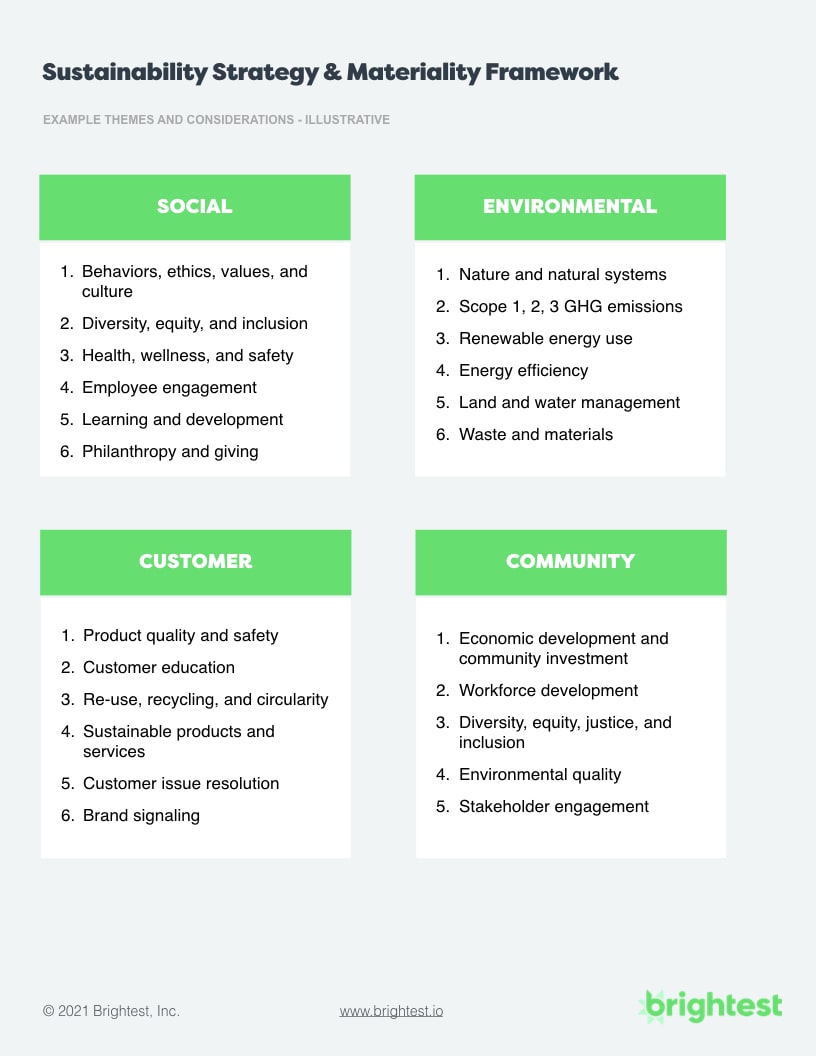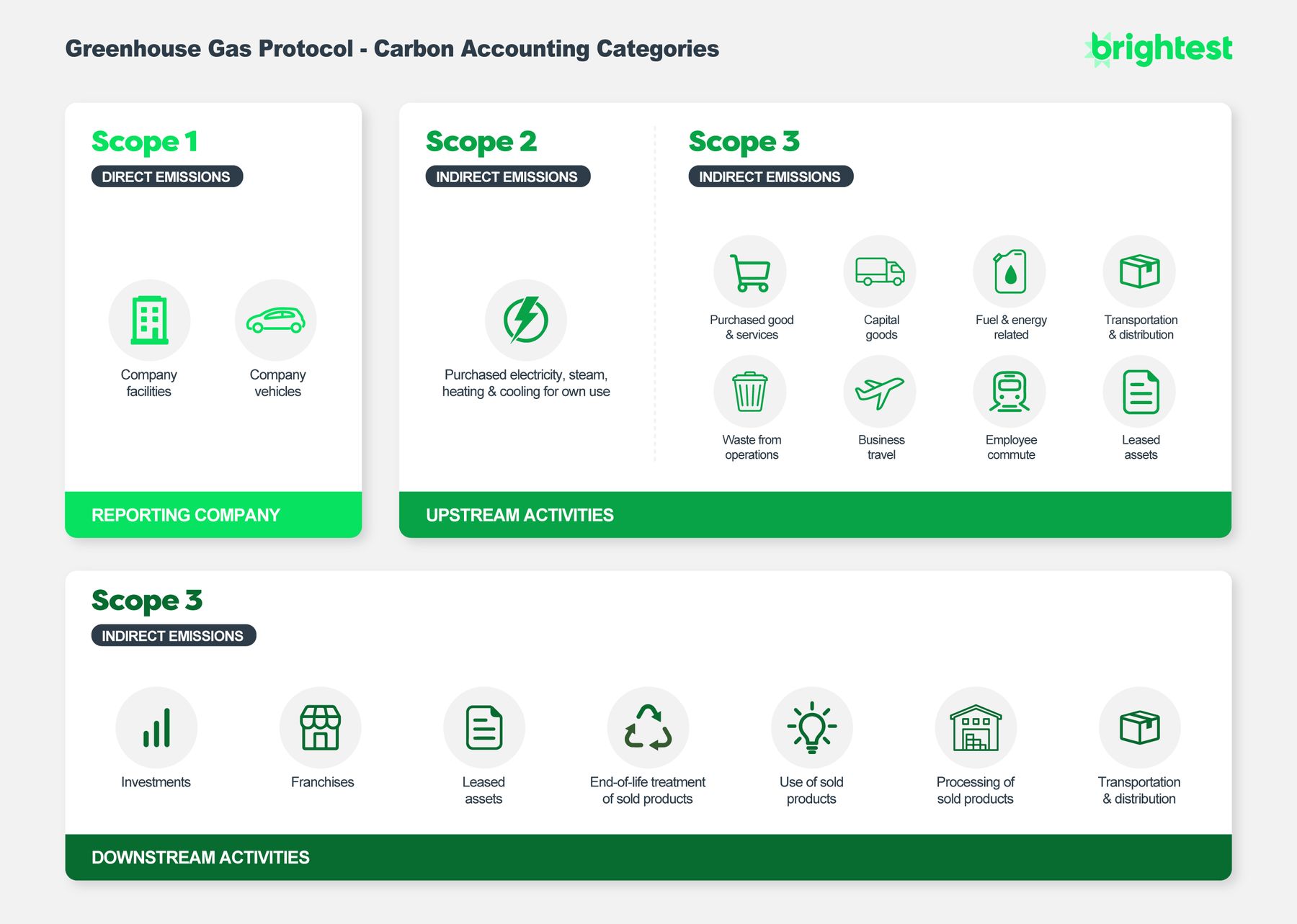Sustainability Strategy: An Overview
As global weather becomes more extreme, ESG pressures mount on companies, and more people raise their voices to demand sustainable products and solutions to their everyday needs, businesses play a critical role in the modern sustainability ecosystem. Companies represent most of the world's sustainability challenges and greenhouse gas emissions (GHG), but also many of the answers and solutions. But before we talk more about sustainability and strategy, let's first define a few key terms and themes.
What is Sustainability (Really)? A Definition
There are many definitions of sustainablity. Most are centered around themes of balance, life, longevity, and the surrounding environment. Sustainability, according to Forum for the Future, is "a dynamic process which enables all people to realize their potential and to improve their quality of life in ways that simultaneously protect and enhance the Earth's life support systems."
Former Norwegian Prime Minister Gro Harlem Brundtland defined sustainability as "meet[ing] the needs of the present without compromising the ability of future generations to meet their own needs."
Indigenous communities, who have lived sustainability on Earth for centuries, typically define sustainability around principles of relationality, community-based governance, quality of life and health, and communal recognition of nature and external, non-human entities as life-givers and enablers.
Sustainability clearly exists to find multi-stakeholder balance between economic, societal, and environmental needs, both now and in the future. It's also a form of systems thinking which recognizes everything is connected, actions cannot be compartmentalized, and no individual, organization, or nation operates by itself.
Sustainability Strategy in Business
When we apply sustainability to business strategy and corporate reputation, the first thing to recognize is how sustainability challenges us to broaden our organizational awareness. We need to understand and measure every aspect of our operations:
- Facilities and offices
- Energy and natural resource usage
- Products we make and sell
- How employees travel and get to work
As well as the full value chain around our organization, including:
- Suppliers
- Partners
- Communities
- Customers
- The natural environment itself
For most companies, this initial awareness and empathy phase is the most important starting point. In fact, we see it as a critically necessary 'step one' in a five-step process to move your organization toward meaningful climate action and decarbonization.
The Five Steps to Design (and Align) a Sustainability Strategy
- Assessment, Awareness, and Materiality
- Stakeholder Alignment and Target-Setting
- Environmental Footprint and GHG Inventory Baseline Measurement
- Emissions Reduction, Offsetting, and Decarbonization
- Measurement, Reporting, Improvement, and Strategy Refinement
Once we consider who we are, where we're at, and what our impacts and influences are, we can design a sustainability strategy around it: a prioritized roadmap of actions, programs, and investments to measure and reduce our environmental footprint, while engaging internal (teammates, management, investors, etc.) and external stakeholders (supply chain, customers, etc.) along the way.

Download a PDF copy of our Sustainability Materiality Framework
Sustainability Assessment, Awareness, and Materiality
The starting point for any sustainability strategy is looking around and thinking critically.
Who are we as an organization? What's our mission and purpose? What are our values? What type of business are we? Who do we impact and influence? What local, national, and global context do we exist in? These answers provide the building blocks for your sustainability strategy. They also inform your understanding of materiality.
The term "materiality" is used a lot in corporate sustainability to essentially mean "what's important." Take the time as an organization early in your sustainablity journey to brainstorm and come up with a thoughtful materiality list of key topics for your business and value chain (feel free to download and use our framework template above as a starting point).
For example, if your company makes and sells a physical product, that's material to your business: you have a supply chain and are consuming materials and resources to create and transport your product. What materials do you use? How sustainable, ethical, and transparent are your sourcing practices? By comparison, if you're a tech startup or consulting firm, offices and employee travel are likely to be more material segments of your business. Prioritize what matters most and fits your brand.
The mistake we see companies make most often here is prioritizing optics over material substance. For example, it might be great marketing to say your products use no plastic. But, if plastic only represents 1% of your environmental footprint is that really material? Is that a winnable narrative for your company long-term? By comparison, if you re-engineer all your product packaging to be made from 100% post-consumer recycled materials, that's likely a lot more material.
It's also important to recognize the reality around your size and scale. If you're a small startup, eliminating paper waste is environmentally nice but perhaps shouldn't be your top priority unless you're looking for low hanging fruit or quick wins. If you're a Fortune 500 company, eliminating paper might save entire forests. You can't do everything at once in sustainability, it's critical to focus and prioritize.
We also recommend referencing and incorporating leading sustainability reporting standards and industry benchmarks. What are the common KPIs and measurements of success in your industry? What are you peers doing? What insights and inspiration can we take away from that?
Stakeholder Alignment and Target-Setting
Organizations achieve their best sustainability outcomes when there's top-down (executive), mid-level (management), and bottom-up (employee) support for change. If executive leadership isn't bought in, empoyees and/or management need to build the business case or social return on investment (SROI) for sustainability. Or, by comparison, if employees are disengaged or uneducated in the importance of sustainability, invest in learning, development, internal communications, education, and consensus-building first.

Whether or not your organization formally reports on its ESG performance, sustainability needs to be part of your company culture and core business practices.
Similarly, it's important to set clear, science-based, and focused targets linked to measurable sustainability KPIs. For more in-depth reading on this topic, see our sustainability measurement guide.
Environmental Footprint and GHG Inventory Baseline Measurement
As the old saying goes, you can't manage what you can't measure. That's why one of the most important steps in bringing your sustainability strategy to life is establishing benchmarks and baselines. What are your organization's biggest environmental impacts? What aspects of your company's operations and value chain generate the most emissions? We need data to inform our strategy on what to focus on and where to prioritize.
As move into environmental measurement, you'll find sustainability's a space with many overlapping frameworks and sustainability reporting standards, which can sometimes make it feel a bit like acronym or alphabet soup. There's Greenhouse Gas Protocol, IRIS, SASB, GRESB, TCFD, the United Nations Sustainable Development Goals (SDGs), CDP, HIGG for apparel companies, as well as B Lab's B-Corporation framework.
Generally, for most organizations, the common, global, established accounting unit for sustainability measurement is the greenhouse gas carbon dioxide (CO2), and "carbon equivalents" (CO2e) - the sum of carbon plus all other emissions like methane converted into carbon. Most medium and large companies now practice "carbon accounting," the process of counting up all their carbon and other emissions from operations, and converting it into one total CO2e number which represents the company's annual carbon budget. In most cases, your first steps in sustainability measurement should be to map and count all your carbon, typically in tons or metric tons (tonnes).
Your carbon accounting should also be categorized into Scope 1, 2 & 3 emissions. Reducing your companies overall GHG emissions should be one of the highest priorities within your overall sustainability strategy.

For most organizations - particularly large ones - we recommend focusing on emissions benchmarks and carbon accounting first, starting with Scope 1 and 2, then broadening to Scope 3. However, sustainability doesn't just start and end with emissions. There's also biodiversity, water usage, waste, materials, and other environmental considerations that may be material to your business and should have targets and KPIs devoted to them.
Measure what matters, and use your materiality analysis to focus and sharpen your lens.
Emissions Reduction, Offsetting, and Decarbonization
GHG emissions reduction targets and other key sustainability targets (like water usage or waste targets, if they apply to your business) are one the best ways to focus, align, and communicate your organization's sustainability strategy. Emissions targets are clear, quantifiable goals and market signals that link your company's purpose and sustainability strategy with a carbon accounting process and operational steps to reduce its environmental footprint.

The right emissions and environmental targets for your organization should balance ambition with feasibility. Too conservative, you're not really decarbonizing or driving positive change, which may look less favorable compared to your peers and competitors (i.e., "greenwashing"). Too ambitious? You may not be able to achieve it and will need to revise or restate your target.
The right balance to a thoughtful, effective strategy and set of targets lies somewhere in the middle.
For more guidance on this topic, see our guide to setting GHG emissions reduction targets, or contact us directly.
While the focus of your sustainability strategy should be on reducing your company's GHG emissions and environmental impacts, there may be a gap between the reductions you can achieve and your overall carbon footprint. To bridge that gap, you can use carbon offsets to make up the difference and bring your company to carbon neutral or net zero.
Sustainability Measurement, Reporting, Improvement, and Strategy Refinement
Now for the most fun and rewarding part: bringing your sustainability strategy to life, learning and improving, and making positive (and much-needed) change happen. Since you've already read this far (and that's quite a lot), we'll leave any further sustainability playbook guidance to other resources published Brightest. And don't forget: every sustainability strategy starts somewhere, even if that may feel small at first. As you build organizational momentum, sustainability initiatives often snowball into big, positive outcomes.
If you need further help or guidance with your sustainability strategy or measurement at any point in your process, our platform and advisory services has helped organizations in dozens of industries establish stronger, clearer environmental sustainability measurement and reporting processes. You're welcome to contact us any time for advice, to suggest helpful content topics, or learn more about our work.
We wish you all the best as you continue your decarbonization journey. A central part of our mission here at Brightest is enabling better data-driven decision-making (and actions) for good.





